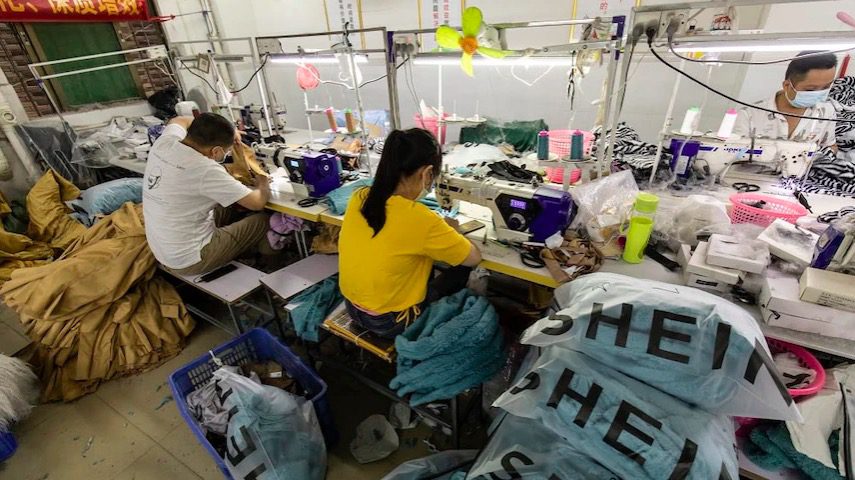
Shein is the new darling of China’s fast fashion industry — but at what cost?
Fast fashion has risen to global domination led by Chinese company Shein.
The company generated $20.5 billion in revenue in 2021, according to Reuters, and its website claims there are almost 9,000 new online arrivals a day.
Its goods are super cheap — you can get a top for $5 or sunglasses for $6 — but its means of achieving low prices for consumers has been criticised for being opaque, driving waste and leading to poor working conditions.
What’s a Shein haul?
China is manufacturing the company’s success — literally — but it’s Gen Z’s TikTokers who are driving Shein’s popularity and growth with viral #sheinhaul posts.
“So I spent $900 on Shein so you don’t have to,” says @jodi.opuda as she empties a large box of Shein-labelled bags of clothes onto her bedroom floor.
“Oh my god, I bought $2,000 worth of stuff and that is my Shein box,” says @clubsilktree pointing to a massive cardboard box being unloaded from a delivery van.
“Did I really just buy $439.50 worth of items off of Shein?” reads a caption by @chlo3s_hauls as she scrolls through the receipt of her latest Shein purchase.
Lizzie Cao, 20, is a university student and a social media influencer with more than 168,000 followers on TikTok.
Shein popped up on her feed about two years ago.
“Especially with TikTok being a very big thing during quarantine or lockdown, everyone was doing Shein hauls,” Lizzie told China Tonight.
“I sort of fell into the trend or just bulk buying Shein products — I didn’t even need it, but that cheap price tag entices you.”
But just as quickly as a trend appears, she says, it’s forgotten.
“I ended up donating to Vinnies or just throwing out most of the items,” she says.
“The quality wasn’t even that good — it was kind of like you get a short-lived satisfaction or high from getting such a trendy item for so little, but the trend goes away, and you don’t need it anymore.”
Creating 20 million tonnes of waste
Shein and companies like it rely on Chinese manufacturing.
In the first two months of 2022, China produced 6 billion metres of clothing fabric, according to Statista.
Dr Yi Li, a Chinese business expert, says that Shein operates like an e-commerce platform for smaller Chinese suppliers — a model that allows them offload a portion of the costs and risks to independent clothing manufacturers.
“Shein can squeeze the manufacturing cost and transfer part of this cost to other franchise suppliers,” Dr Li says.
“So that’s why it can offer 9,000 items per day, and most of the things are much cheaper.”
Suppliers also bear some of the costs of unwanted items.
“Maybe more than 90 per cent of these items are not popular at all,” he says, “they just need a few items to be very popular — then they can guarantee the profits.”

Many Shein workers are underpaid, unsafe and underage
In February, Shein released its first Sustainability and Social Impact Report for 2021, addressing transparency complaints.
It revealed 83 per cent of 700 suppliers had at least one major risk, 12 per cent had major violations that threatened closure, and close to a third were not prepared for a fire.
Underage labour was found is less than one per cent of nearly 700 suppliers where audits were conducted — that’s between one and six of its suppliers.
China has ratified the International Labour Organisation’s Minimum Age Convention, 1973, and specified a minimum working age of 16 years.
Swiss Watchdog, Public Eye, released a report last year that revealed findings from investigators in China.
“They all work 11 to 12 hours a day,” says Timo Kollbrunner, a researcher for Public Eye, “and that’s not five times a week, but seven times a week.”
“They usually have one day off per month.”
His investigators spoke to 10 workers from six factories in Guangzhou, China.
“Not one of the workers interviewed has a contract, not one of the workers interviewed had received any social security benefits,” Mr Kollbrunner says.
The investigators visited the factories as well and found buildings with no fire exits, blocked hallways and bars on windows.
A spokesperson for Shein told ABC’s China Tonight that they enforce a code of conduct for all suppliers and have strict audits using third party firms.
“We also partner with third-party audit firms such as Bureau Veritas, ITS and Openview to audit our suppliers,” they said.
They said the company is committed to protecting the environment, supporting communities, and empowering entrepreneurs.
“A major global online retailer, we know that we have a vital role to play in supporting the communities where we work, source, and live, and a responsibility to preserve the planet we all share. We seek to take ownership of all the impacts of our business and operate for the long term in a way that benefits business and society.”
Are Gen Z turning their backs on fast fashion?
Shein’s Gen-Z consumer base has started voicing concerns over the fast fashion industry, and #boycottshein is now gaining traction on TikTok.

“When I purchased from Shein, it was sort of like a too good to be true moment,” Lizzie says.
“Then you start to uncover and understand the repercussions behind buying from a fast fashion company.”
“I sort of distanced myself, and I feel like a lot of influencers that I’m in touch with also distanced themselves from fast fashion companies as well.”
Time will tell how Shein and its fast fashion peers will address these issues, but for now, they are still Australia’s number one shopping app.
